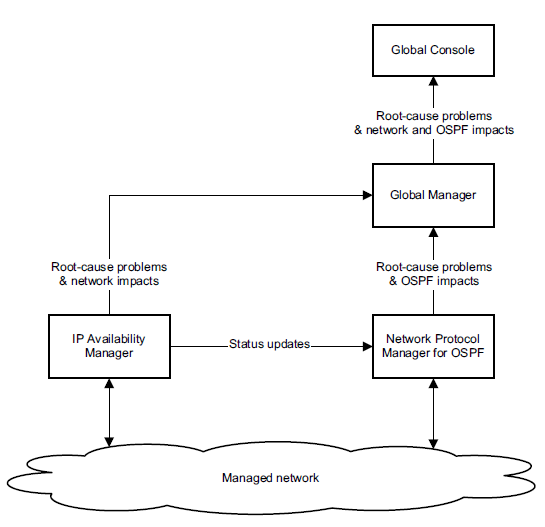OSPF failures, or apparent failures, that are detected by Network Protocol Manager for OSPF cannot be analyzed in isolation. Rather, those failures must be correlated with the physical-transport failures that are detected by IP Availability Manager in order to determine the root-cause problem that is underlying all observed symptoms. Network Protocol Manager for OSPF analyzes OSPF and physical-transport failures to determine whether an OSPF failure is indeed a root-cause problem, or simply a symptom (impact) of an underlying physical-transport root-cause problem.
When Network Protocol Manager for OSPF detects an OSPF failure, it checks for any physical-transport problem that might be causing the failure. If it does not find such a problem, Network Protocol Manager for OSPF focuses its analysis on just the OSPF domain and performs the root-cause analysis described in Chapter 3, “OSPF Objects and their Failures.”
If it does find such a problem, Network Protocol Manager for OSPF diagnoses the OSPF failure as an impact and exports the underlying physical-transport problem and the OSPF failure to the Global Manager. The Global Manager responds by adding the OSPF failure as an impact of the underlying physical-transport root-cause problem.
OSPF and global impact analysis shows the flow of information between the components in a Network Protocol Manager for OSPF deployment to achieve OSPF and global impact analysis.

Status updates received from IP Availability Manager identifies the IP Availability Manager status updates to which Network Protocol Manager for OSPF subscribes.
| Object |
Problem-type status |
Event-type status |
|---|---|---|
| 1**Indentation indicates class hierarchy. 2**Perceived as a problem-type status by Network Protocol Manager for OSPF. |
||
| Card |
Down |
|
| NetworkAdapter Interface 1 Port |
Disabled, Down |
|
| NetworkConnection Cable 1 TrunkCable |
DownOrFlapping 2 |
|
| UnitaryComputerSystem Router 1 Switch and so on |
Unresponsive 2 |
|
Network Protocol Manager for OSPF imports status information from IP Availability Manager through a remote (proxy) accessor, as shown in Remote accessor operation for Network Protocol Manager for OSPF.

“Update object attributes” in Figure 19 corresponds to “Status updates” in OSPF and global impact analysis and in Status updates received from IP Availability Manager. Status updates represent changes to problem-type and event-type instrumentation attribute values.
Adding IP Availability Manager as a source to Network Protocol Manager for OSPF causes Network Protocol Manager for OSPF to import topology and status from the IP Availability Manager. The VMware Smart Assurance Network Protocol Manager Discovery Guide Supplement provides the instructions for completing this task.